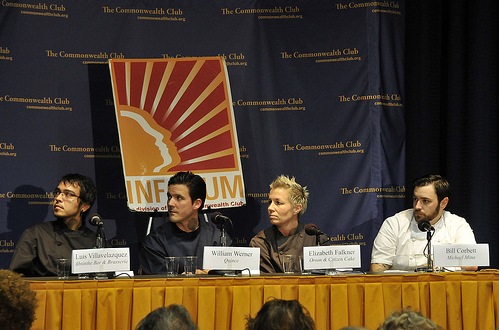That was the takeaway from last Tuesday's INFORUM panel at the Commonwealth Club, where four of the city's most innovative pastry chefs gathered to discuss The State of Pastry in SF. On the panel were Luis Villavelasquez (Absinthe), William Werner (Quince), Elizabeth Falkner (Orson, Citizen Cake), and Bill Corbett, recently of Michael Mina. The questions tossed out by moderator Jessica Battalina, associate food editor of 7x7, were marshmallow-soft, but some interesting tidbits did arise.
On NYC vs. SF Pastry Styles:
Corbett: I spent 5 years cooking in New York before I came to California. New York chefs can't rely on getting really excellent produce all the time, so it forces their creativity.
(True: Would Momofuku's Christina Tosi be so obsessed with cereal milk if she had Betty Van Dyke's apricots in her backyard?)
Falkner: Here, we don't have time to screw around with stuff that's only going to be here for a couple of weeks, like elephant-heart plums or Indian red peaches.
On Wooing Diners to Weirdness:
Corbett: It helps to put it into a recognizable form. If I want to use beets, for example, I might use them in a red velvet cake, because everyone knows what that is.
Villavelasquez: In Japan, they use a lot of Okinawa blue potatoes, which are not well know here. But we do have sweet potato pie, so you could use them in something like that.
Of course, as artists as well as artisans, these chefs would love to play to an audience eager and willing for innovation. But then again, restaurants are businesses, and change comes at a price. Unfamiliar flavors tend to sneak via the fine print. At Quince, Werner gives his pear tart a bump with a side of rosemary ice cream. At Absinthe, the earthy sweetness of a carrot reduction plays off the mellow spice of a pumpkin custard, while at Orson, creole cream cheese and Tabasco gives a kick in the shins to sticky toffee pudding. Sometimes, though, two great tastes don't go great together. . .
Epic Fails?
Corbett: When I started at Michael Mina, I had lofty intentions—I was going to be the one to show customers how to break out. I did this chocolate plate that had a basil s'more, a tahini chocolate mousse. . . all that was fine until I put in this perfect cube of devil's food cake with black olives. Now, I love chocolate and olives, I think they go really well together. But I realized that when people saw what they thought was a piece of devil's food cake, they expected one thing. So, you can't make an unfamiliar thing look too familiar.
Werner: Anchovy croissants. It was a humbling experience.
Falkner: Trying to transport an elaborate wedding cake on a hot summer day in the backseat of an old Pinto with no A/C. I got to the Sherman House with the cake melted all over me, and they just looked at me, like, 'What kind of punk-ass are you'?
Current Obsessions?
Falkner: Hydrocolloids! That's what I say to everyone these days. I feel like that guy in The Graduate, telling Dustin Hoffman to get into plastics.
Werner: Persimmons, because I don't really like them. I'm forcing myself to use them and see what I can do.
Corbett: Squash. It's a very autumnal ingredient. You can put it in cake, foams, all kinds of things.
Villavelasquez: Coconut, bourbon, persimmons. I ask my chefs to think about how the season tastes. I'm also very into garam masala right now.
Classic and Perfect, or Provocative but Flawed?
Given the chance to enjoy a perfectly made, perfectly simple pear tart, or to taste a more experimental dish that didn't quite work, which would they pick?
Falkner: Pastry chefs don't eat dessert! Steak or a pizza, that's you want at the end of the day.
What about you, Werner? Do you order dessert?
Werner: Not unless the pastry chef sees me.
Only Villavelasquez admitted to dessert splurges, saving up to eat nothing but desserts—sometimes 4 or 5 in a sitting—at restaurants that intrigue him here or abroad. But all agreed that as creative artists interested in pushing, pulling and poking at the concept of the sweet course, they'd go for the flawed experiment every time.
Corbett: In a classic dessert, there's no tricks, nothing to hide. But for me right now the most exciting desserts are the ones that the most innovative and new.
Inspirations?
Falkner: Song titles or lyrics. We've got a dessert now called "Mesh and Lace." Sometimes the title comes first, like "Burning Down the House": you think, what would that be? Sometimes it's based on a gesture, something sculptural or conceptual, or wanting to create a texture that doesn't exist yet.
Villavelasquez: Asian and Japanese flavors and ingredients. There are a lot of innovative textures, ingredients, and spices that are unfamiliar here. Also, just putting 3 flavors out there and making them work.
So, What's the Next Bacon?
Corbett: Porcini syrup.
Falkner: Deeper salts. Olives.
Werner: Soy and miso.
Villavelasquez: I had a jasmine cupcake somewhere, and that led to a scone we're doing at Arlequin, with quince, jasmine, and earl grey tea. I'm thinking like a bartender these days, thinking about using floral syrups and waters like jasmine, violet, orange blossom. Lavender's used up. But in the end, it comes down to butter all the way.
